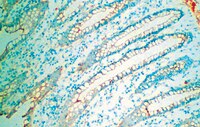Covalent grafting of fibronectin onto plasma-treated PTFE: influence of the conjugation strategy on fibronectin biological activity.
Karine Vallières,Eric Petitclerc,Gaétan Laroche
Macromolecular bioscience
7
2007
Show Abstract
Surface coating of synthetic materials is often considered to improve biomedical devices biocompatibility. In this study, we covalently bound fibronectin (FN) onto ammonia plasma-treated PTFE via two crosslinkers, namely glutaric anhydride (GA) and sulfosuccinimidyl-4-(p-maleimidophenyl)butyrate (sulfo-SMPB). With respect to clean PTFE, cell adhesion increased markedly on both FN grafted surfaces, although it was twice higher on PTFE-GA-FN than on PTFE-SMPB-FN. ELISA experiments performed with a polyclonal antibody revealed that the amount of FN is identical on both surfaces while monoclonal antibody specific to the RGD binding site clearly demonstrated a greater availability when FN is surface grafted through GA. These results provide evidence of a variation in protein conformation correlated with the surface conjugation strategy. | 17457945
 |
Modulating cell adhesion and spreading by control of FnIII7-10 orientation on charged self-assembled monolayers (SAMs) of alkanethiolates.
Hua Wang, Yi He, Buddy D Ratner, Shaoyi Jiang
Journal of biomedical materials research. Part A
77
672-8
2006
Show Abstract
In this work, we demonstrate that surface charge can be used to modulate cell adhesion/spreading through the control of the orientation of adsorbed FnIII(7-10), which is a cell-adhesive protein containing RGD residues. Carboxylic acid (COOH) and amine (NH(2))-terminated self-assembled monolayers (SAMs) of alkanethiolates were used as model negatively and positively charged surfaces, respectively. The adsorbed amount of FnIII(7-10) is controlled to be equivalent on both SAMs as confirmed by the adsorption isotherms determined using I(125)-radiolabeled FnIII(7-10.) The binding of a monoclonal antibody specific for the cell-binding domain of FnIII(7-10) was measured by surface plasmon resonance (SPR) to evaluate FnIII(7-10) orientations on different SAMs. Results indicate that adsorbed FnIII(7-10) on NH(2)-SAM has an orientation with more cell-binding domains accessible than on COOH-SAM, confirming our predictions from Monte Carlo simulations. Both phase contrast images and Vybrant MTT cell proliferation assays show that the adhesion/spreading of bovine aortic endothelial cells (BAECs) on the NH(2)-SAM is significantly better than that on the COOH-SAM coated with an equivalent amount of FnIII(7-10). These results indicate that surface charge can be used to specifically orient cell adhesive proteins such as FnIII(7-10), thus providing a promising strategy to increase the activity of materials incorporating biological moieties. | 16514600
 |
Tumor-driven paracrine platelet-derived growth factor receptor alpha signaling is a key determinant of stromal cell recruitment in a model of human lung carcinoma.
Tejada, ML; Yu, L; Dong, J; Jung, K; Meng, G; Peale, FV; Frantz, GD; Hall, L; Liang, X; Gerber, HP; Ferrara, N
Clinical cancer research : an official journal of the American Association for Cancer Research
12
2676-88
2006
Show Abstract
Activated fibroblasts are thought to play important roles in the progression of many solid tumors, but little is known about the mechanisms responsible for the recruitment of fibroblasts in tumors. Using several methods, we identified platelet-derived growth factor A (PDGFA) as the major fibroblast chemoattractant and mitogen from conditioned medium generated by the Calu-6 lung carcinoma cell line. In addition, we showed that Calu-6 tumors express significant levels of PDGFC, and that the levels of expression of these two PDGFRalpha ligands correlate strongly with the degree of stromal fibroblast infiltration into the tumor mass. The most intense expression of PDGFRalpha was observed in fibroblasts in the tumor outer rim. We subsequently showed that disrupting PDGFRalpha-mediated signaling results in significant inhibition of tumor growth in vivo. Furthermore, analysis of a compendium of microarray data revealed significant expression of PDGFA, PDGFC, and PDGFRalpha in human lung tumors. We propose that therapies targeting this stromal cell type may be effective in treating certain types of solid tumors. | 16675559
 |
Internalization of antibodies by endothelial cells via fibronectin implicating a novel mechanism in lupus nephritis.
Fujii, H; Nakatani, K; Arita, N; Ito, MR; Terada, M; Miyazaki, T; Yoshida, M; Ono, M; Fujiwara, T; Saiga, K; Ota, T; Ohtani, H; Lockwood, M; Sasaki, T; Nose, M
Kidney international
64
1662-70
2003
Show Abstract
One of the crucial events in lupus nephritis is the glomerular deposition of immunoglobulins (Igs), of which pathogenic properties have been proposed mostly to be either type IIor type III allergic reactions. Some of IgG3-producing hybridoma clones established from an MRL/MpTn-gld/gld (MRL/gld) lupus mouse generate wire loop-like lesions in glomeruli resembling lupus nephritis when injected into SCID mice. These clones are useful for analyzing the mechanisms of glomerular deposition of antibodies in lupus nephritis at the monoclonal level.Glomerular lesions of SCID mice injected with the hybridoma clones, 17H8a or 1G3 as control were analyzed by light and electron microscopy. Interaction of the antibodies with human glomerular endothelial cells (HGECs) and human umbilical vein endothelial cells (HUVECs) in vitro was studied by fluorescence microscopy, electron microscopy, and flow cytometry.Both antibodies did not show any antigen specificity for mouse glomeruli. The glomerular lesions generated by 17H8a, but not by 1G3, contained electron-dense deposits not only in subendothelial regions but also in the cytoplasm of endothelial cells, suggesting internalization of the 17H8a antibodies by endothelial cells. In cell culture studies, internalization of only 17H8a antibodies by HGECs and HUVECs was observed, but the antibodies did not have antigen specificity for both types of endothelial cells. The internalization by HUVECs was mediated by actin polymerization, and it was inhibited by RGDS (Arg-Gly-Asp-Ser) tetrapeptide, antihuman fibronectin and antihuman integrin beta1 monoclonal antibodies.The interaction between particular antibodies and endothelial cell surface integrins via fibronectin may be involved in their subsequent internalization by endothelial cells leading to antibody deposition in glomeruli. This may be one of the mechanisms of glomerular injury in lupus nephritis. | 14531798
 |












